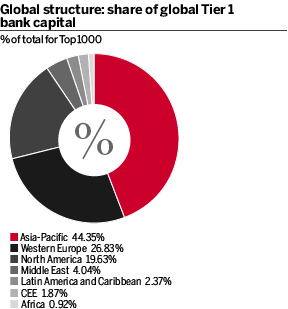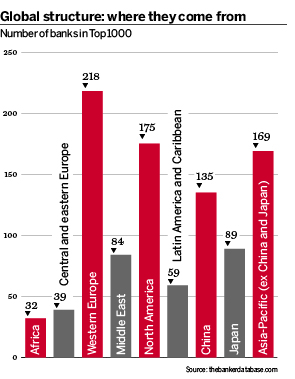Global banking is in generally good and improving health judging by the aggregate figures of 2018’s Top 1000 World Banks ranking. Total profits have tipped over the trillion-dollar mark at $1112bn after climbing 15.6% since the 2017 ranking. This is nearly 10 times the profit level a decade ago when the financial crisis ravaged bank profits in the 2009 ranking. It follows two years of declining profits.
But the best news is that this profits increase does not appear to be a gain at the expense of higher risk taking. Tier 1 capital has also advanced in step with an 11.7% rise to a record $8235bn while assets marched ahead more moderately with a 9% rise to $123,700bn.
As a consequence, the capital-to-assets ratio has improved moderately and the return on capital at 13.5% – while a little higher than 2017’s figure of 13.04% – is in the same range as for the past seven years. After plummeting to 2.69% in the 2009 ranking, return on capital first recovered to 8.16% in the 2010 ranking and has stayed in a 12% to 14.5% range ever since. This means that while many banks are doing well and either hitting this level or exceeding it, other banks are below this level and not making sufficient returns to keep their shareholders happy.
At the other extreme, return on capital was north of 20% in the 2008 ranking (based on 2007 data) the last year before the crisis. This should have been a warning that something was amiss. Return of capital varies hugely depending on region from 26.4% in Africa to 8.03% in Japan and 10.19% in Europe.
As for global structure, the Asia-Pacific region has increased its share of global Tier 1 bank capital to 44.35% from 42.51% in the 2017 ranking, gaining at the expense of both North America and Latin America and the Caribbean. North America’s share fell 1.92 percentage points to 19.63% while Latin America and the Caribbean slipped 0.91 of a percentage point to 2.37% – a very meagre share given the size of the region, but reflecting the economic troubles many countries are facing. Venezuela is excluded from the ranking this year due to the distorting effects of hyperinflation and this obviously has an impact.
Western Europe’s share has remained more or less the same at 26.83%, with the three big regions of Asia-Pacific, Western Europe and North America continuing to hold roughly 90% of global banking capital, illustrating a very unequal distribution around the world despite strong economic growth in some emerging markets in Africa, the Middle East and central and eastern Europe.
Western Europe’s number of banks within the Top 1000 stays the same at 218, North America loses four to move to 175 and China gains nine to a record 135, as shown in the 'Where they come from' table.






